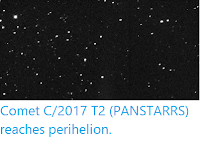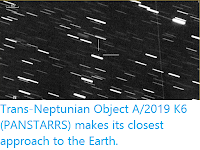Comet C/2019 K7 (Smith) will reach its perihelion (the closest
point
on its orbit to the Sun) at 6.32 pm GMT on Tuesday 16 June 2020, when it
was
approximately 4.48 AU from the Sun (i.e. 448% of the distance between
the
Earth and the Sun, roughly three times as far from the Sun as the planet Mars). At
this time the comet will be 3.81 AU from the Earth, in the
constellation of Delphinus, having a magnitude of 16.0 (roughly the same as Pluto's moon Charon), making it visible with only the largest Earth-based telescopes, although it may be possible to capture an image of it with a smaller telescope linked to a camera with a sufficiently long exposure.
Comet C/2019 K7 (Smith) imaged on 5 October 2019 using a 60 second exposure of from a 345 mm telescope. The comet is the point at the centre of the image indicated by the two yellow lines. Toshihiko Ikemura/Hirohisa Sato/Seiichi Yoshida.
Comet C/2019 K7 (Smith) was discovered on 30 May 2019 by astronomer Ken Smith using the Atlas MLO Telescope at Mauna Loa Observatory in Hawaii. The designation C/2019 K7 (Smith) implies that the object is a comet (C/), that it was the seventh such object discovered (7) in the second half of May 2019 (period 2019 K) and that it was discovered by Smith.
The orbit and current position of C/2019 K7 (Smith). The Sky Live 3D Solar System Simulator.
C/2019 K7 (Smith) is a Parabolic Comet, which is to say a comet that
has been disrupted from an orbit in the Oort Cloud, and to be passing
through the Inner Solar System on a parabolic orbit that will probably
not bring it back again. This parabolic trajectory tilted
at an angle of 103° to the plain of the Solar System.
See also...
Follow Sciency Thoughts on Facebook.








